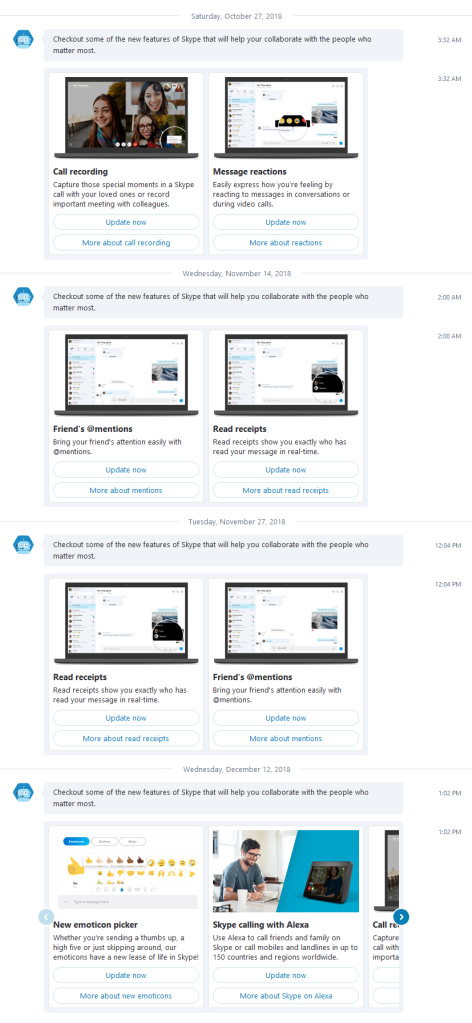Category Archives: Messenger
Messenger Flash Reviver brings winks back

| Download Messenger Flash Reviver |
| Version 1.0.0.0 SHA-1: 23098BE0BD0F63E50F9FEFF8F1694363142EF1A9 SHA-256: 240F03B39FE73B115B85AB563B081A716B828B0FA3EA3B10B1F7E0EDBAEECA55 |
With the immediate demise of Adobe Flash, Messenger Flash Reviver restores the Flash-enabled features (winks, dynamic display pictures) of all versions of Windows Live Messenger and MSN Messenger by installing a portable version of Flash and then modifying Messenger to use it.
Having a problem? Post in the comments below or visit this MessengerGeek forum topic.
How to use
- Download and run Messenger Flash Reviver
- The Windows Live Messenger or MSN Messenger executable file will be automatically detected, or alternatively, you can select the location of the file in any Messenger installation
- Press the Start button
- Messenger will be Flash revived, and then restarted for use
Requirements
- Any version of MSN Messenger or Windows Live Messenger, in any language
- Any version of Windows XP, Windows Vista, Windows 7, Windows 8, or Windows 10
Additional Features
- Optional automatic backup of modified file
- Optional restart of Messenger
- Full logging
- Command line parameters
- Silly little easter egg
- UI available in English, Spanish, French, Hungarian, Dutch, Portuguese, Russian and Greek
Command Line Parameters
Messenger Flash Reviver includes command line arguments for the use in scripts and automation.
| /run | Automatically starts reviving |
| /exe [PathToExe] | Sets the path to the Messenger executable file |
| /nobackup | Disables making a backup of the file before reviving |
| /nomsgrstart | Disables Messenger from being restarted |
| /norestartwin | If files are not modifiable, prevents Windows from being restarted to complete reviving (automatic Windows restart feature triggered by /run) |
| /? or /help | Shows this helpful table |
Errors return errorlevels -2 through -10, successes return 0 or 2, view errorlevel documentation.
Version History
| Dec 30 2020 | 1.0.0.0 | First release of Messenger Flash Reviver |
Skype 7 blocked from signing in but you can still use older versions
EDIT Jan 16 2019: The 7.40 version stopped working for me today, but downgrading to 7.36 restored the ability to sign in. I’ve updated the article accordingly.
Coinciding with Update “Patch” Tuesday on January 8th, the latest version of Skype “Classic” 7 is no longer allowing users to sign in and instead prompts you to update:
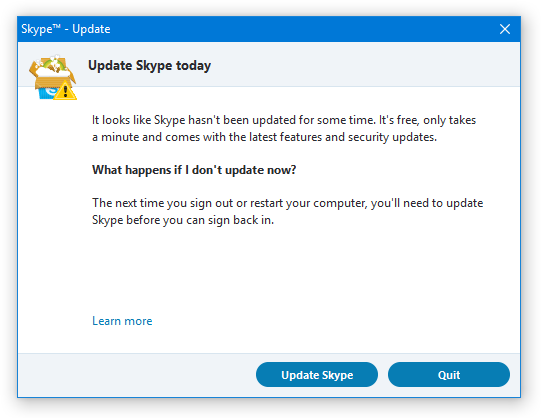
“It looks like Skype hasn’t been updated for some time. It’s free, only takes a minute and comes with the latest features and security updates.”
Despite the “What happens if I don’t update now?” and “The next time you sign out or restart your computer” verbiage, I’ve only seen the message pop up after you’ve been signed out or if you try to sign in on a computer that’s been offline.
How to keep using Skype 7
Strangely enough, instead of utilizing their prior version-pushing capabilities, only the last version of Skype 7 seems to contain the code to show the above forced upgrade message and using a previous version of Skype 7 will still allow you to sign in.
To continue using Skype 7, download and install the 7.36 version (7.36.0.101). When the confirmation prompt appears, choose OK to install the older version.
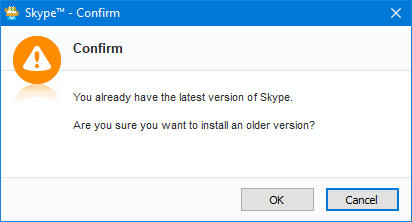
Skype should operate just as before. One small caveat I have noticed on PCs that do not have Skype already installed previously, the username and password are not being saved and Skype prompts for credentials on every sign in.
Additionally, to avoid upgrade prompts, it appears copying the installer in your profile’s temp folder (Open up Start, type %localappdata%\temp and press Enter to get there), rename the file to SkypeSetup (so technically SkypeSetup.exe) and then right-click, select Properties and set the file to read only.
How long the older versions will continue to work is anyone’s guess, but my prediction is Skype will watch as people are slowly forced off the old version until the user population of 7 is low enough to pull the plug on the servers/protocol version.
The battle for Skype 7
Just to step back a minute, this is not an unplanned or surprising event. Back in September, Skype claimed that they would be ending support for Skype Classic on the desktop on November 1st and for mobile platforms, on the 15th. This never happened and we moved into the new year with Skype Classic still operating normally.
And that wasn’t the first announcement either, back in July it was announced they would end support on September 1st, which then was subsequently changed in August to “extended support for some time”.
They’ve also been prodding users with upgrade messages and tidbits on their new features of the latest version for many months:
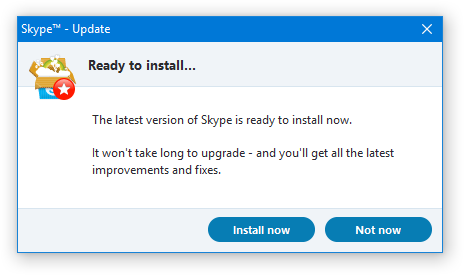
My primary reasons for sticking with Skype 7 are the integration with my headset’s buttons and LED indicators, easy access to my 13 years of message history, and the many benefits of using a real, non-web based application.
The end of MSN Protocol (MSNP)
Back in August, Bruce Lowekamp, Principal Architect for Skype’s Cloud Infrastructure, did a fascinating talk on “Skype’s Journey from P2P” which among other great information, was littered with small details on Skype’s past and current infrastructure. I made some detailed notes of the entire presentation, but it was mentioned that Skype moved from Messenger’s protocol to “New Chat Service”. Although I have no evidence of this at present, I would imagine the Messenger protocol is what is to be removed once Skype 7 no longer works in any form, and thus marking the final end of the Messenger protocol.
Upgrade paths and other options
There are a few options available when Skype 7 will no longer work:
- The official upgrade path, Skype 8, is an electron/web-based application, and thereby uses quite a lot of memory, generally is weak on performance and as far as I am aware of presently, message history is stored “on the cloud” for two years only.
- The built-in Windows 10 Skype UWP version uses far less memory, far less CPU and power, and still does still save to a local database format which appears to be exportable using anything that can read SQLite 3 databases.
- EionRobb’s regularly maintained SkypeWeb for libpurple-enabled clients (Pidgin, Bitlbee, and others) allows use of Skype using a third-party client. However, voice/video calls are not yet supported.
I plan on trying the UWP version full-time if/when Skype 7 becomes unusable as it seems like the best option, especially when my usage of Skype is primarily for voice calls.
A special thanks to my friend Nojus for discovering that prior versions of Skype 7 were still working.
The New Skype
Exactly two weeks since the last Messenger server twinkled out of existence comes the announcement of “New Skype“. See Skype’s promotional video below:
At present, this is only an announcement and the software has not yet been released. However from what is shown in the video, I have a few questions, observations and opinions already.Are there any (MSN or Windows Live) Messenger features?I generally evaluate new messaging clients by comparing them against Messenger’s standard set of features. Based on what we know so far, I don’t see any sign of New Skype of backgrounds, custom emoticons, custom fonts, nudge, status (presence), or voiceclips.

Background colours with gradients in New Skype
It does appear you can set a background colour (and gradient!) for the text of an individual message reminiscent of the background colour functions in the modern versions of Messenger Plus!. However, it’s not entirely clear if this feature expands to allowing you to change the colour of the actual text. In the screenshots, a background colour swapped the font colour from black to white.
Winks (called Stickers) do exist in New Skype and are animated, as well as the normal expected GIF support and Skype’s own “Mojis”.New Skype appears to have a Snapchat stories-like Highlights feature for material you want to share with all your contacts for a seven-day period. Of course, this stories feature is the latest variant of what was once Messenger 2009’s “What’s new?” pane as well as 2011/2012’s social pane.Will all the problems be fixed?
Although I haven’t had a lot of exposure time to the iOS version of Skype, I have had quite a lot of time with the Android version and its whole slew of reliability and performance problems. From time to time, I’ve resorted to uninstalling Skype on my phone because of weird glitchy behaviour that has made the phone unusable or drained the battery. I do hope a lot of these issues have been ironed out since they’ve taken steps to drastically change the client. Additionally, Skype recently ranked as using the most mobile data in comparison to other mobile messaging clients, and hopefully that has also been improved.
Why so much white?
Everyone I have shown the promo video to has had the same immediate reaction I did – there’s just way too much white space.
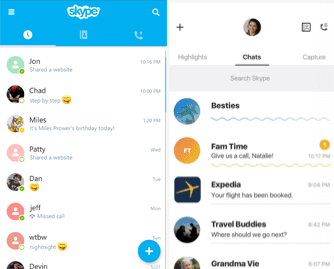
Old Skype vs New Skype
It reminds me of Office 2013’s attempt at white everywhere in its default theme, which was also unpleasant
Particularly on phones, I can’t think of anyone who wants to be blinded by a mobile screen first thing in the morning or replying to a message late at night in the dark.
Although I would prefer a dark background option, I rather like the look of the current mobile Skype. It retains the classic Skype colour and fits in with whatever native operating system it’s on.
Will it be compatible with current Skype?
I would assume yes, but it’s not explicitly mentioned anywhere. I find it a bit weird that I would have to consider such a question, but Yahoo! had no qualms in completely eliminating its existing Yahoo! Messenger service/contact lists last year in favour of the “new Yahoo! Messenger”.
What about the desktop version?
As part of the announcement is Windows and Mac versions. I do wonder if the Windows version will be yet another variant of Skype. At present, there are two Skype Windows versions – the classic Win32 version you download from the website and the new Universal Windows version (excluding Skype for Business versions as that operates on local servers or Office 365). At the very least, I would assume New Skype to also be written for the Universal Windows Platform (UWP).
I use the Win32 version of Skype, primarily because it does have a (albeit limited) API that ties in with my headset’s software, notifying the headset base of calls, allowing a button on the headset to answer calls and an LED to let others around me know I’m in a call with someone. On top of that, the Win32 version provides a local message history spanning all the way back to my first main use of Skype, I can log into multiple accounts at once and particularly important, my taskbar icon for Skype lights up when I get a message (a feature not available in Universal Windows applications at present).
I don’t think any of the features in New Skype would be compelling enough to lose such valuable features from the classic version of Skype.
Final thoughts
Overall, this update appears to be an attempt to “keep up” with the other modern messaging services today and less about trying anything particularly new or interesting. When the New Skype does get released in some form, I’ll do another comparison.
For now though my advice to the Skype team is simple, please, please, please provide a dark theme option.
Messenger Reviver 2 Discontinued
It is with a heavy heart that I announce that Messenger Reviver 2 has come to an end. 
On May 18th, 2017 Microsoft shut down the last Messenger server, preventing Windows Live Messenger from being revived any further.
MSN Messenger first came online July 22, 1999 making public access to the servers available for a total of 17 years, 9 months and 27 days. In the 2000s, Messenger dominated the instant messaging world, being used for text, voice, video, remote assistance, game invitations, and enjoyed both for business and personal use. Massive communities and long-lasting relationships were formed around all around the world on Messenger-related websites and tools like mess.be and Messenger Plus! Even today, despite hundreds of new messaging applications, still no client has yet to match the features and customization options of Windows Live Messenger.
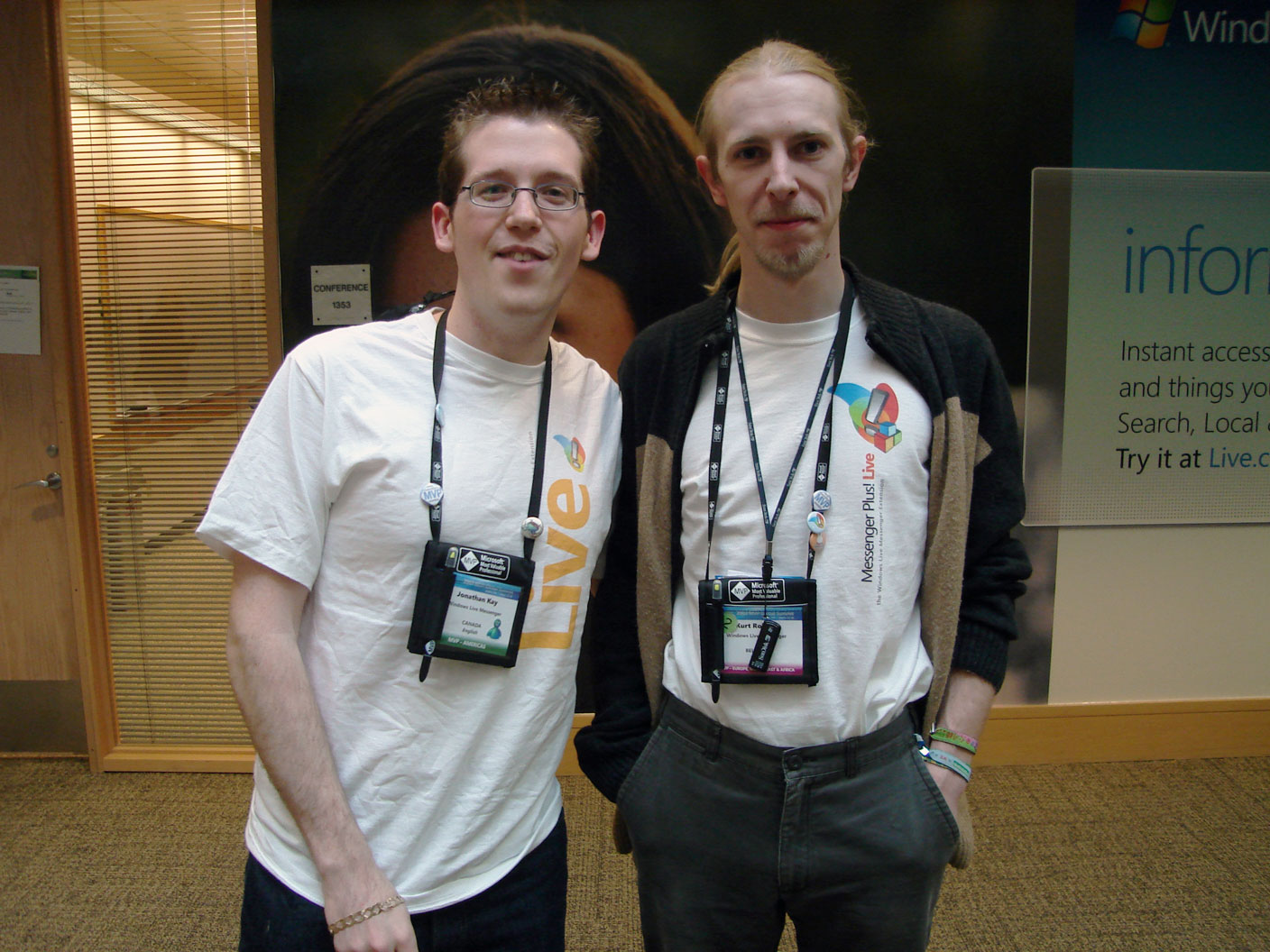
Messenger MVPs – Jonathan and Kurt Robaer at Microsoft, 2007
I originally got involved with the Messenger community back in 2001 as part of the Windows XP beta “Associate Experts” program, and quickly became a Microsoft MVP for Messenger, a position I held for over 10 years. After Messenger officially “shut down”, I released Reviver to continue making Messenger connect to the Microsoft servers, and that has continued for over four years, with 98 versions of changes and fixes. The original versions of Reviver only required a small adjustment to Messenger itself, but later on DNS servers, proxy servers and even modifications to Windows itself were needed to keep Messenger working. I also expanded into versions on OS X/MacOS for Messenger:Mac and Adium, as well as aMSN. It’s been quite a ride!
Previously, I have not taken donations for my work but as this is the end of the Messenger Reviver 2 chapter, I feel comfortable now putting out my PayPal tip jar for any who feels Reviver has been useful to them over the years.
Back in 2015 when it first appeared that the Messenger servers might not be available for much longer, I recorded a video of myself going through all the available versions of Messenger discussing and comparing the various features as well as telling some stories about the software. I present it to you below or you can watch it on YouTube:
Although you can no longer use Messenger with the public Microsoft servers, you can continue using the older versions of Messenger on a new private server called Escargot. You can find contacts to add on this forum topic.
This blog, forum and chat will continue operating, so please stay subscribed for news and discussion on Escargot and other Messenger related topics.
You have a several options to continue to communicate to your contacts on what was formerly known as the .NET Messenger network. Of course, you can use Skype, but also Miranda-NG, Pidgin with EionRobb’s, SkypeWeb plugin, or SkypeWeb with other libpurple-compatible clients like Bitlbee. You can also use the web-versions of Skype at https://web.skype.com or on https://outlook.com.
 A final version of Messenger Reviver 2 is now available that you can download as a memento which retains all the original features you can explore or even just open it up to play around with the Easter eggs.
A final version of Messenger Reviver 2 is now available that you can download as a memento which retains all the original features you can explore or even just open it up to play around with the Easter eggs.
If you have looked at the Reviver About screen previously, you would have seen many important people who made Reviver possible when it was first released. For the final release, I’ve also added the people who have been vital over the years I have been supporting and working on Reviver, and I would like to thank them here too: Emil, John, Tasos, Dean, Petri, Jeff, Mariano, Esteban, Peri, Alexis, dx, Jacko, Javier, and Raul, thank you for your friendship, endless discussions about Messenger, many late nights and supporting me and my projects.

Jonathan and Patchou in 2006
Additionally, I would like to thank Patchou for creating Messenger Plus! Plus! was the cornerstone of the Messenger community for many years, indispensable for adding missing vital Messenger features and responsible for many relationships and careers for so many people. Furthermore, I’d like to thank wtbw for always being available for reverse engineering assistance and pointers.
Thanks to Valtron for building the new private Messenger server and giving Messenger continued life.
Finally, a special thanks to all of you who have been users of Messenger Reviver 2 for so long. You have made this journey a great and memorable part of my life and I greatly appreciate all the kind words and support over the years. Please stay in touch! You can reach me on the new Escargot server by adding the user trekie@jonathankay.com, on Skype by adding trekie, my website, the forum, or here on this blog.
I think it’s appropriate to end with my favourite wink, the UFO, which can be both a hello and a goodbye.

Jonathan Kay

Hello there, MSN butterfly!
Messenger presently offline
At approximately 15:45 UTC, the Messenger bn2 servers have stopped responding. Investigations are still underway but you will be unable to connect.
You will receive the following possible error codes: 80072efd, 81000306 and 80072efd 81000301.
If you are still signed in, do not sign out or you will not be able to sign in again at the moment.
EDIT: Scanning through IP ranges hasn’t found a suitable replacement, Butterfly Messenger and the Windows 8.0 client do not appear to be working either. Skype is still working.
EDIT 2: Also of note, if Messenger cannot be restored, all focus will shift towards the Escargot server and continuing its development. Visit the forum for discussion and contacts to add.
EDIT 3: After more scanning and hoping, there’s no sign of the public Messenger server. Unfortunately this means, Messenger Reviver 2 support will have to end. If you haven’t already done so, please read my final Reviver 2 post as I’ve tried my best to pay tribute to a great messaging client and service.
Happy fourth anniversary Messenger Reviver 2!
What a dizzying four years, but Messenger is still (mostly) usable. Unfortunately more features such as groups (with a workaround) have stopped working, and conversion to Office 365 on Hotmail has caused a multitude of contact list issues, even for Skype-based Messenger users.
In case you haven’t been watching the forum, recently the ever awesome valtron has put up a Messenger Protocol server for older versions of Messenger as the Microsoft server stopped accepting older clients back in 2015. Give it a try!
Happy Anniversary! ![]()
Messenger and the Windows Essentials installers removed from Microsoft servers
At what is no surprise to anyone, the Windows Essentials have disappeared from the Microsoft servers.
I did prepare for this situation for Reviver use and the Essentials installer files have been saved. However, this does mean that installing Messenger for the time being will now be a larger download at 100MB.
Additionally, not all the languages will be available for the next few hours, if there is one you are in need of right now, please let me know in the comments and I’ll move it up in queue. All languages are now available.
Signing out of the Skype app on Windows 10 Anniversary Update
If you use Windows 10, no doubt you have updated to the Anniversary Update (Version 1607, build 14393) which has a built-in Skype app called Skype Preview.
After using Reviver to revive Messenger on the new version of Windows, you may notice that Messenger will tell you you’re signed into multiple locations with the same device name.

This will happen if you use your Microsoft account to sign into Windows and the Skype app will automatically make use of your Microsoft account to sign you into the .NET Messenger network.
The biggest problem with this is that you’ll remain signed into Messenger, even if you’re signed out of Messenger or your computer is off as the Skype app operates on the Microsoft servers. Additionally, even if you use Messenger to force the Skype app to sign out, the app will eventually sign you back in again on its own.
Thankfully you can choose to sign out of the Skype app and use the real Messenger client exclusively. To do so, just head over to the Start menu and click on the Skype Preview tile (or find it on the applications list under S).

When the Skype app opens, choose the hamburger menu button in the top corner and then choose your name at the bottom.

You’ll then find a Sign out link under your name and info, clicking on the link should sign you out and then close the Skype app automatically.

Now you’ll only be signed into one location.

Signing out of the Skype app has been maintained through the insider builds, so you should hopefully only need to do this once. You can always start the Skype app and sign in again if you would like to try the app at a later time.
Happy third anniversary Messenger Reviver 2!
Happy Anniversary
It was on this day, three years ago, that Messenger sign-ins started being blocked by the official Messenger client and three years ago that Messenger Reviver 2 was released.
Although we’ve lost some features over time, access to versions prior to 2009 and unfortunately most of the third-party clients haven’t kept up with the required changes, you can still use Windows Live Messenger today.
Thank you for your support!
Recent Messenger outages
UPDATE (2016-02-12): After more investigation, it seems the DNS reported in some regions (especially in Europe) will connect you to servers that are no longer operating. Reviver has been updated to fix this issue. If you are having this problem, please revive Messenger again using Messenger Reviver 2.4.7.

In the last 24-36 hours, a handful of users have been reporting infrequent outages resulting in error code 80072efd (can’t connect to the server). Waiting a few minutes and just trying again usually will remedy the problem.
Four days ago it was reported on the forum that all the bn1 category servers had disappeared, but the actual connectivity problems with Messenger were not reported until several days later.
So far I have not seen the issue on any of my accounts and therefore have not yet been able to properly investigate the situation. However, at the moment my best guess is that the servers are being reorganized in some way and when you get the error message, you’ve been redirected to a server that is no longer operating. At the end of 2014, the same problem occurred when some of the servers started to phase out direct MSNP and HTTP access. However, I think this might a bit of a different situation.
Although it may or may not be related, during the same time period I have also seen some disconnections with Skype causing it to sign out completely, which usually mean the server has signed me out automatically. These sign outs might indicate that Skype’s infrastructure is also being changed too.
Unfortunately the inner-workings of the Messenger servers have never been completely fully known, so we’ll have to continue monitoring to see what happens.


